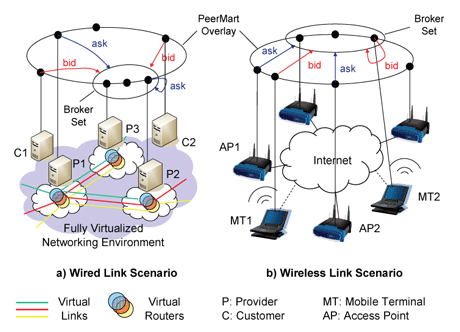by David Hausheer and Burkhard Stiller
PeerMart defines a fully decentralized auction-based marketplace layered on top of a peer-to-peer (P2P) network, and makes the trading of services over the Internet technically and economically feasible. While being generally applicable to any service-trading scenario, PeerMart shows great potential as a new method for scalable and reliable bandwidth trading on demand.
The Internet is becoming increasingly popular as an electronic marketplace. As a result of rapid technological progress, the near future will show a wide variety of goods and services being traded over the Internet by huge numbers of buyers and sellers. Such a vast marketplace requires reliable trading mechanisms that are truly efficient and scalable.
At the same time, peer-to-peer (P2P) networks are emerging as a new design approach for building scalable and fault-tolerant applications. By means of resource aggregation and replication, P2P-based applications benefit from peer resources that otherwise lie unused, and thus provide much better performance and greater robustness than traditional client/server-based applications.
PeerMart Architecture and Design
PeerMart is a fully decentralized auction-based marketplace layered on top of a P2P network (see Figure 1). It combines the economic efficiency of double auctions with the technical performance and scalability of structured P2P networks. The solution supersedes the need for a central auctioneer by distributing broker functionality over all peers. Redundancy is used to achieve robustness even in the presence of malicious peers.

The auction-based pricing mechanism is complemented by a decentralized accounting scheme called PeerMint, which provides accountability for applications in a secure and scalable manner. The scheme uses multiple distributed account holders and session mediation peers to store and update accounting information on individual peers and sessions. It also enables peers to be charged for service usage in an aggregated manner.
David Hausheer and his advisor Prof. Burkhard Stiller at the Institute TIK at ETH Zurich developed PeerMart’s fully decentralized market approach during Hausheer’s PhD candidacy. The work was completed in 2005. A prototype of the design has been implemented in Java using the FreePastry structured P2P overlay library, and will be made available under an open-source licence. Detailed experiments were performed with the prototype to provide evidence of the mechanisms’ efficiency and reliability even in the presence of faulty or malicious peers.
Bandwidth Trading on Demand
While PeerMart is generally applicable to any distributed trading scenario like P2P file sharing, Grid computing, or decentralized storage systems, the approach is particularly interesting for bandwidth-trading scenarios. Electronic marketplaces for trading bandwidth have emerged since the late 1990s, but were seriously hit by the economic downturn in 2001. However, driven by recent technical advances, especially in the area of optical fibre technology and virtual router infrastructures, the provision of bandwidth services ‘on demand’, being offered just like other commodities, will become a reality.
Today, bandwidth services are normally provided under the umbrella of long-term bilateral peering and transit agreements between individual Internet service providers and customers. Appropriate mechanisms for trading such services in an efficient and scalable fashion among multiple providers and customers are not yet available. A new workshop on bandwidth on demand (BoD) has therefore been established to bring together researchers from both industry and academia. The scope of the workshop includes the technical and economic dimensions of BoD mechanisms, legislative and regulatory issues, and the industrial development of new technology that supports these mechanisms.
To meet the individual requirements of bandwidth services, the generic PeerMart design is currently being refined and extended in a follow-up post-doc project at the University of Zurich, IFI. This includes the support of key service parameters like bandwidth, reliability, delay and jitter, as well as start-time and duration of such services. The adapted trading mechanism will enable users to buy and sell bandwidth services on demand or in advance, and will also allow the reselling of unused bandwidth services to other users.
Application Scenarios
As depicted in Figure 2, two different applications have been defined which will benefit from decentralized support for bandwidth services. One application is targeted at trading bandwidth over optical links in a wired, fully virtualized networking infrastructure. The other focuses on trading Internet services over access points between Internet access providers and end-users in wireless hotspots.

Fully virtual network environments are a promising future platform for Internet service providers and large end-customers, who may use them, for example, to sustain parts of an ISP's network or to carry traffic for broadcasting large sporting events. Using synchronous optical network (SONET) circuits, or wavelength-division multiplexing (WDM) technology supporting ‘virtual’ lightpaths, multiple bandwidth-guaranteed tunnels can be carried over a single optical dark fibre. In conjunction with new router platforms such as Cisco's CSR-1, which have the ability to provide secure virtualisation, routers themselves can be separated into multiple virtual routing engines. This enables the deployment of dedicated, bandwidth-guaranteed networks on top of fully virtual networking infrastructure. Using PeerMart’s trading mechanisms, customers and providers of such a virtual network platform will be able to buy and sell fully virtual networks composed of virtual nodes and network links across different physical locations, adapting their capacity as necessary.
The second application shows that PeerMart can also be applied to wireless scenarios. At wireless hotspots like airports, train stations or other crowded areas, there are typically multiple users equipped with mobile terminals (laptops, mobile phones, PDAs etc) seeking access to the Internet. At the same time there may be several Internet access providers available and running multiple wireless access points. With PeerMart, it is possible to determine prices for such services in an economically efficient and scalable way based on the current supply and demand. Moreover, through the use of redundancy PeerMart can ensure high reliability of its trading mechanisms even in the presence of malicious or unreliable peers.
Future work will include an integration of the developed bandwidth-trading mechanisms into real hardware devices such as open-source routers, access points, and end-user devices, which will enable a deployment of these mechanisms into production environments such as Internet eXchange Points (IXPs) or wireless hotspots.
Links:
PeerMart Project: http://www.peermart.net/
PeerMart Dissertation: http://hausheer.osola.com/publications/dissertation.pdf
BoD Workshop: http://www.csg.unizh.ch/events/bod06/
FreePastry Project: http://freepastry.org/
Please contact:
David Hausheer
University of Zurich, IFI, Switzerland
Tel: +41 44 635 43 72
E-mail: hausheer![]() ifi.unizh.ch
ifi.unizh.ch










